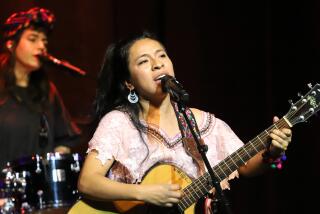SUKAY AT UC IRVINE : MUSIC FROM THE ANDES, OLD AND NEW
- Share via
The concept of East meets West is, by now, almost old hat. American performing artists visit China with casual regularity these days, and vice versa.
But here’s a twist: How about North meets South?
The quartet Sukay (pronounced osue-KYE) certainly fills that bill. The group, which will appear at the UC Irvine University Center Heritage Room tonight at 8, wears the traditional garb and plays the authentic instruments of the Andes, but two of its four members are from the top half of the globe.
Quentin Howard, the only woman, hails from Brooklyn, N.Y., and Edmond Badoux was born in Switzerland. On first hearing, both fell instantly in love with the subtle, complex rhythms and the lyrical, gentle melodies of Ecuador, Bolivia and Peru--the way most people seem to do.
“I was a graphic artist in the early ‘70s,” Howard recalled in a phone conversation from San Francisco, the group’s home base. “I went to a folk festival in 1973 and heard Edmond performing with an Andean group. One guy gave me a kena (a notched flute), and I started to learn on my own.”
She giggles at the memory: “I had never touched a flute before.” Learning mostly by ear, with occasional lessons from Badoux (another self-taught musician), Howard soon improved to the point where, in 1975, she and her instructor could play as a duo. Then they traveled to South America.
And North met South.
In Bolivia, Badoux and Howard befriended a pair of local musicians, and Sukay (meaning “to prepare the earth for planting”) was born. Though some changes have come along the way--the two Bolivians left the group, Badoux and Howard were married, then divorced--the unique combination of players from north and south of the Equator has remained.
“When we were in Chicago last summer,” Howard says, “we met this great Bolivian musician, Carlos Crespo. When he heard us, he liked what we were doing and joined us.” Howard, Badoux, Crespo and another Bolivian, Omar Sepulveda, became the new Sukay. Howard couldn’t be more excited at the peculiar chemistry of the group.
“Edmond and I are into studying the music that is more traditional, but Carlos and Omar represent the new kind of music.”
The new kind of music?
Howard explains that in Bolivia and Peru, there is a new wave of interest in traditional music. “During the ‘40s and ‘50s, the young people down there discovered rock music, and the older stuff, handed down from father to son, got pushed aside.
“But then, the Bolivians and Peruvians discovered that Europeans were responding to their traditional music, and they began to appreciate what they had.
“The younger players started to create a whole new music, using older instruments.”
Carlos Crespo is one of those younger players. “He’s a great songwriter,” Howard enthuses.
The quartet’s concerts are now evenly divided between the traditional tunes (instrumental and vocal) and new songs in the traditional style from Peru, Ecuador and Bolivia. Will the audience be able to tell the difference?
“You want to know something?” Howard responds. “I remember a time when I couldn’t tell the difference between Peruvian and Bolivian music. But, in a way, it’s like a foreigner being confused by American cowboy music and music from the Appalachians.”
Not to worry, however. Howard and Badoux are enthusiastic tour guides.
And, of course, the music does its own explaining. “So many times,” Howard notes, “people come up to us afterward and say, ‘Gee, I feel so good, and I came in feeling miserable. Now I feel full of energy.’ ”
Howard giggles in near embarrassment. “I still feel the same way, sometimes.”
More to Read
The biggest entertainment stories
Get our big stories about Hollywood, film, television, music, arts, culture and more right in your inbox as soon as they publish.
You may occasionally receive promotional content from the Los Angeles Times.










